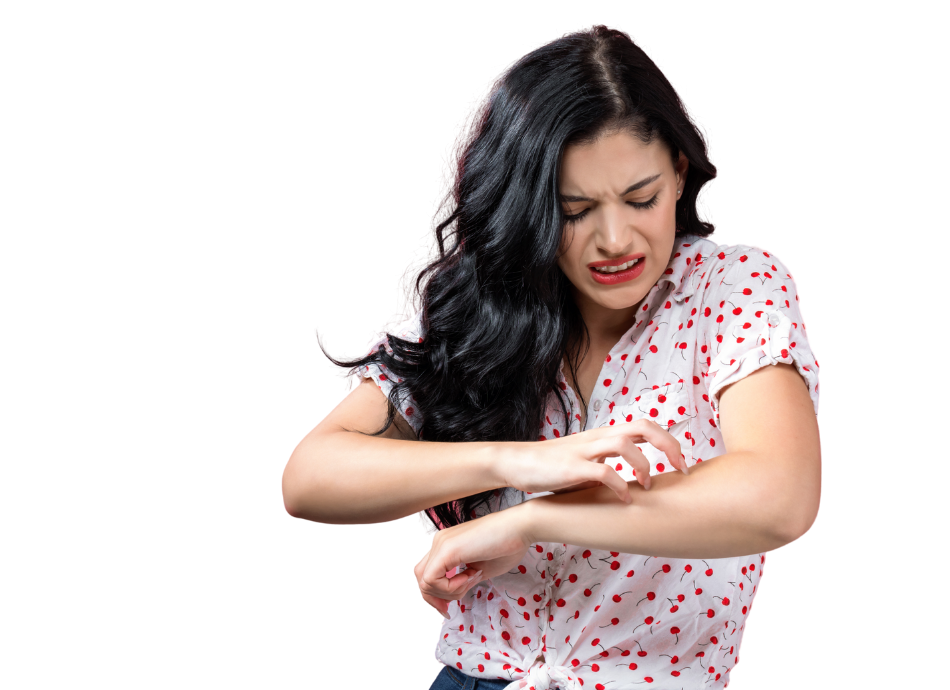Chronic hives
Also known as chronic urticaria
Key points about chronic hives
- Chronic hives (urticaria) is an itchy rash which happens most days for more than 6 weeks.
- Symptoms are the same as in acute hives, but last longer.
- Although chronic hives clear up in months to a few years for most people, some people will experience long-term symptoms.
- Treatment includes avoiding any known triggers and taking antihistamines.

Hives (urticaria) are itchy skin-coloured or pale swellings on the surface of your skin, usually surrounded by redness, that last anything from a few minutes to 24 hours. The symptoms are the same as acute hives.
Acute hives last less than 6 weeks. Chronic hives happen most days for more than 6 weeks.
Chronic hives can be inducible (physical) or spontaneous. You can have both types at the same time.
Inducible or physical chronic urticaria
This is a reaction to a known external factor. This includes hives caused by the following:
- stroking your skin (dermographism) – this is the most common type of inducible/physical urticaria
- exposure to cold, cold water and cold objects (cold urticaria)
- sweating (cholinergic urticaria)
- direct contact with a substance such as stinging nettles, foods, preservatives, fragrances, plant and animal products, metals and rubber latex (contact urticaria) – this is different to dermatitis, which develops hours or days later
- pressure to your skin – this can be an immediate or delayed reaction (pressure/delayed pressure urticaria)
- exposure to sunlight or to artificial ultraviolet (UV) light (solar urticaria)
- direct contact of warmth to your skin (heat urticaria)
- exposing your skin to vibration, repetitive stretching or rubbing (vibratory urticaria)
- contact with water (aquagenic urticaria).
Some of these types are quite rare. The rash appears within 5 minutes of the trigger and lasts for about an hour.
Spontaneous chronic urticaria
This is when the trigger for hives is not known. It's more common in women. The cause is likely to be an autoimmune reaction.
Spontaneous chronic hives have also been associated with:
- chronic underlying infection, eg Helicobactor pylori, bowel parasites
- chronic autoimmune diseases, eg, systemic lupus erythematosus, thyroid disease, coeliac disease or vitiligo.
The image below shows an example of what each type looks like.

Image credit: DermNet NZ
Chronic hives are diagnosed if you have a long history (more than 6 weeks) of daily or regular hives. Your healthcare provider will take a family history and do a physical examination.
Inducible hives are often confirmed by inducing the reaction, eg, scratching your skin in dermographism or applying an ice cube if cold urticaria is suspected.
Your healthcare provider may ask for blood tests to rule out underlying conditions.
Most people with chronic hives manage with appropriate doses of non-drowsy antihistamines (eg, cetirizine and loratadine). The doses for chronic hives are usually higher than the usually recommended doses. Although referred to as 'non-sedating', these medicines may still cause drowsiness, especially at higher doses, so take care when driving or operating machinery. If antihistamines work well you'll need to keep taking them for 2 to 3 months after your hives go away, or they'll come back.
If the cause is a specific trigger, avoiding those foods or substances will reduce the risk of your hives coming back again. Also avoid anything that can make hives worse (eg, tight clothing, excessive heat, spicy foods, NSAIDs, opioid medicines or alcohol).
Steroid or antihistamine creams aren't helpful and may cause skin changes or skin irritation.
If you have severe symptoms interfering with your quality of life, and antihistamines haven't worked well, you may be referred to a clinical immunology/allergy specialist or dermatologist. They will do an assessment and consider additional medicines.
Apps reviewed by Healthify
You may find it useful to look at some Skin care (dermatology) apps.
Although chronic hives clear up in most cases, 15% of people continue to have symptoms at least twice weekly after 2 years.
The chance of chronic spontaneous urticaria going away within 3 years is 30 to 50% and after 5 years is 40 to 70%.
Chronic inducible urticaria seems to be less likely to go away, particularly cold urticaria and solar urticaria.
Chronic urticaria(external link) NHS, UK
Images of urticaria and angioedema(external link) DermNet NZ
Apps
References
- Hives (urticaria)(external link) Australasian Society of Clinical Immunology and Allergy (ASCIA), 2019
- Acute urticaria(external link) DermNet NZ
- Hives(external link) NHS, UK, 2021
- Urticaria(external link) Auckland Regional HealthPathways, NZ, 2017
Credits: Healthify editorial team. Healthify is brought to you by Health Navigator Charitable Trust.
Reviewed by: Dr Emma Dunning, Clinical Editor and Advisor
Last reviewed:





